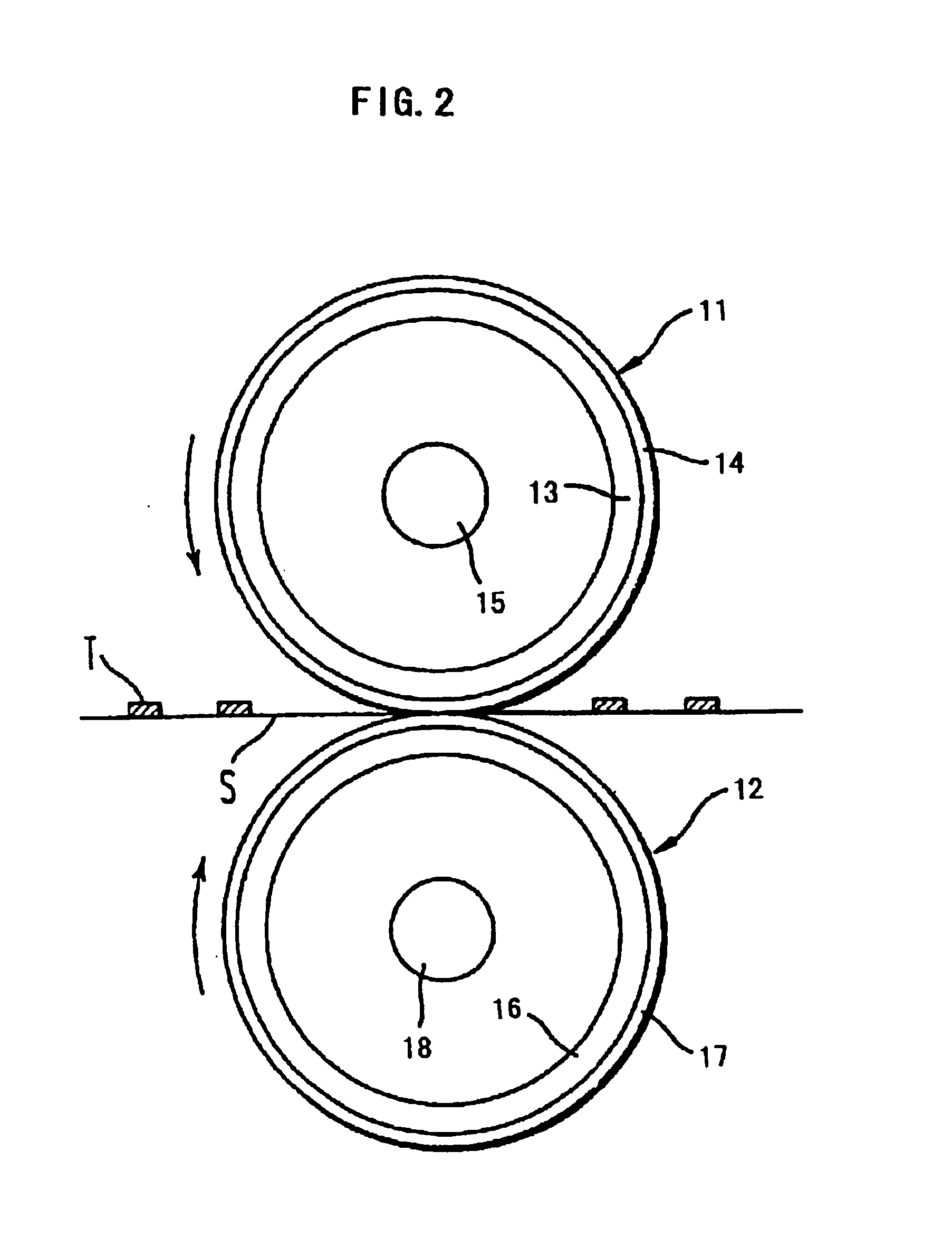Image forming method and toner for use in the method
a technology of toner and forming method, which is applied in the direction of electrographic process, electrographic process using charge pattern, instruments, etc., can solve the problems of insufficient toner image fixation on the sheet, the heating roller fixing method is not easy to work, and the temperature of the surface of the heating roller is apt to decrease, etc., to achieve high-grade toner
- Summary
- Abstract
- Description
- Claims
- Application Information
AI Technical Summary
Benefits of technology
Problems solved by technology
Method used
Image
Examples
example 1
[0078]
Styrene-n-butyl acrylate copolymer75 parts(weight average molecular weight: 253,000)Styrene-n-butyl methacrylate copolymer10 parts(weight average molecular weight: 23,000)Carbon black (trade name: #44, manufactured10 partsby Mitsubishi Chemical Corp.Charge controlling agent (trade name: Spiron 2 partsBlack TR-H, manufactured by HodogayaChemical Corp.)Low molecular weight polyethylene 3 parts
[0079]The above components were mixed using a two axis kneader at 40° C. The kneaded mixture was cooled, pulverized and classified. The thus obtained mother toner had a weight average particle diameter of 10.5 μm. To the mother toner particles, 0.4 part of hydrophobic silica (R972 manufactured by Clariant Japan) as an external additive was mixed using HENSCHEL MIXER to obtain Toner (1). The Toner (1) was then mixed with a carrier which was obtained by coating ferrite particles having an average particle diameter of 80 μm with a silicone resin to obtain a Developer (1) having a toner content...
example 2
[0104]
Styrene-butyl acrylate copolymer50 parts(weight average molecular weight: 350,000)Styrene-n-butyl methacrylate copolymer33 parts(weight average molecular weight: 39,000)Carbon black (trade name: #44, manufactured10 partsby Mitsubishi Chemical Corp.)Charge controlling agent (trade name: Spiron 2 partsBlack TR-H, manufactured by HodogayaChemical Corp.)Carnauba wax 5 parts
[0105]The above components were mixed using a two axis kneader at 110° C. The kneaded mixture was cooled, pulverized and classified. The thus obtained mother toner had a weight average particle diameter of 10.5 μm. To the mother toner particles, 0.4 part of hydrophobic silica (R972 manufactured by Clariant Japan) as an external additive was mixed using HENSCHEL MIXER to obtain Toner (2). The Toner (2) was then mixed with a carrier which was obtained by coating ferrite particles having an average particle diameter of 80 μm with a silicone resin to obtain a Developer (2) having a toner content of 4% by weight. The...
example 3
[0106]
Styrene-butyl acrylate copolymer53 parts(weight average molecular weight: 280,000)Styrene-2-ethylhexyl acrylate-n-butyl30 partsmethacrylate terpolymer(weight average molecular weight: 31,000)Carbon black (trade name: #44, manufactured10 partsby Mitsubishi Chemical Corp.)Charge controlling agent (trade name: Spiron 2 partsBlack TR-H, manufactured by HodogayaChemical Corp.)Carnauba wax 5 parts
[0107]The above components were mixed using a two axis kneader at 100° C. The kneaded mixture was cooled, pulverized and classified. The thus obtained mother toner had a weight average particle diameter of 10.5 μm. To the mother toner particles, 0.4 part of hydrophobic silica (R972 manufactured by Clariant Japan) as an external additive was mixed using HENSCHEL MIXER to obtain Toner (3). The Toner (3) was then mixed with a carrier which was obtained by coating ferrite particles having an average particle diameter of 80 μm with a silicone resin to obtain a Developer (3) having a toner conten...
PUM
| Property | Measurement | Unit |
|---|---|---|
| volume change Vt | aaaaa | aaaaa |
| volume change Vt | aaaaa | aaaaa |
| melt viscosity | aaaaa | aaaaa |
Abstract
Description
Claims
Application Information
 Login to View More
Login to View More - R&D
- Intellectual Property
- Life Sciences
- Materials
- Tech Scout
- Unparalleled Data Quality
- Higher Quality Content
- 60% Fewer Hallucinations
Browse by: Latest US Patents, China's latest patents, Technical Efficacy Thesaurus, Application Domain, Technology Topic, Popular Technical Reports.
© 2025 PatSnap. All rights reserved.Legal|Privacy policy|Modern Slavery Act Transparency Statement|Sitemap|About US| Contact US: help@patsnap.com



